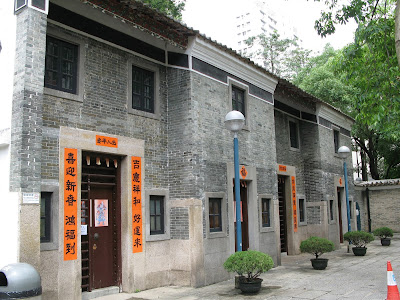Whenever I visit Tsuen Wan I always feel the place has a bit of an identity crisis � part new town, part old market town and part industrial centre. It�s a bit of a mess I feel, and wandering around the �newer� parts of town is often an exercise in problem solving as you attempt to find the most convenient flyover in order to simply cross the road. It�s a bit of a pain if you are not familiar with the place. Perhaps this can be explained by the fact that Tsuen Wan�s transformation into a New Town was the first of its kind in HK and, as such, a bit experimental in nature.
Regardless of the reason, what you find now is a place where old village buildings can be found stuck in the middle of urban residential high rises of various ages and provide a stark contrast between Tsuen Wan now and then.
Perhaps the most well known of these places is the Sam Tung Uk museum � a former Hakka walled village which has been preserved in-situ to offer the modern urban dweller a look into how life in Tsuen Wan really was like. Certainly less well-known although of similar value in terms of local heritage is the Tak Wah Park that has been created from the former village of Hoi Pa.
Granted, only a few of the original village buildings remain but those that do have been incorporated into this well-designed Chinese style garden that provides some relaxing respite from the badly-planned (pedestrian wise at least) clutter that surrounds it.
Hoi Pa was once a rural community sitting right next to the sea. Then, in the 1960�s, along came the Colonial Administration who wanted to resume the village land to facilitate the creation of Tsuen Wan �New Town�. Hoi Pa was just one of many villages that struck a deal to relocate � in this case to the hillside above town � and the former village land now sits slap bang in the middle of the busy town centre.
However, in a move that is not commonly found here, not all of the land and/or village buildings were bulldozed for condominium space and instead what we now have is this small but very attractive park.
There are several original buildings inside the park�s boundary and in fact one, built in 1904, is a gazetted monument that now serves as the Environmental Resource Centre.
The other is a large row of 1930�s village houses that have been amalgamated into what is now used as a gallery for local cultural exhibits.
There�s a couple more buildings dotted around, the following one looks to be either an old temple or Ancestral Hall, but the one in the following shot seems to have been created with the Chinese-style of the park in mind and certainly isn�t part of the original village structures. I imagine it was built when the first phase of the park was created in the late 80�s.
Anyway, the park has various fish ponds, Taoist rock-scapes, waterfalls, trees, moon gates, pavilions, bridges and sculptures � all of which are the typical ingredients for a nice Chinese-styled park.
Regardless of the reason, what you find now is a place where old village buildings can be found stuck in the middle of urban residential high rises of various ages and provide a stark contrast between Tsuen Wan now and then.
Perhaps the most well known of these places is the Sam Tung Uk museum � a former Hakka walled village which has been preserved in-situ to offer the modern urban dweller a look into how life in Tsuen Wan really was like. Certainly less well-known although of similar value in terms of local heritage is the Tak Wah Park that has been created from the former village of Hoi Pa.
Park Pai Lau
Granted, only a few of the original village buildings remain but those that do have been incorporated into this well-designed Chinese style garden that provides some relaxing respite from the badly-planned (pedestrian wise at least) clutter that surrounds it.
Hoi Pa was once a rural community sitting right next to the sea. Then, in the 1960�s, along came the Colonial Administration who wanted to resume the village land to facilitate the creation of Tsuen Wan �New Town�. Hoi Pa was just one of many villages that struck a deal to relocate � in this case to the hillside above town � and the former village land now sits slap bang in the middle of the busy town centre.
However, in a move that is not commonly found here, not all of the land and/or village buildings were bulldozed for condominium space and instead what we now have is this small but very attractive park.
There are several original buildings inside the park�s boundary and in fact one, built in 1904, is a gazetted monument that now serves as the Environmental Resource Centre.
Environmental Resources Centre
The other is a large row of 1930�s village houses that have been amalgamated into what is now used as a gallery for local cultural exhibits.
The Tak Wah Gallery Building
There�s a couple more buildings dotted around, the following one looks to be either an old temple or Ancestral Hall, but the one in the following shot seems to have been created with the Chinese-style of the park in mind and certainly isn�t part of the original village structures. I imagine it was built when the first phase of the park was created in the late 80�s.
Anyway, the park has various fish ponds, Taoist rock-scapes, waterfalls, trees, moon gates, pavilions, bridges and sculptures � all of which are the typical ingredients for a nice Chinese-styled park.













0 komentar:
Post a Comment
Note: Only a member of this blog may post a comment.